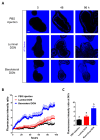Mycotoxin Deoxynivalenol Has Different Impacts on Intestinal Barrier and Stem Cells by Its Route of Exposure
- PMID: 32987679
- PMCID: PMC7598581
- DOI: 10.3390/toxins12100610
Mycotoxin Deoxynivalenol Has Different Impacts on Intestinal Barrier and Stem Cells by Its Route of Exposure
Abstract
The different effects of deoxynivalenol (DON) on intestinal barrier and stem cells by its route of exposure remain less known. We explored the toxic effects of DON on intestinal barrier functions and stem cells after DON microinjection (luminal exposure) or addition to a culture medium (basolateral exposure) using three-dimensional mouse intestinal organoids (enteroids). The influx test using fluorescein-labeled dextran showed that basolateral DON exposure (1 micromolar (µM) disrupted intestinal barrier functions in enteroids compared with luminal DON exposure at the same concentration. Moreover, an immunofluorescence experiment of intestinal epithelial proteins, such as E-cadherin, claudin, zonula occludens-1 (ZO-1), and occludin, exhibited that only basolateral DON exposure broke down intestinal epithelial integrity. A time-lapse analysis using enteroids from leucine-rich repeat-containing G-protein-coupled receptor 5 (Lgr5)-enhanced green fluorescence protein (EGFP) transgenic mice and 5-ethynyl-2-deoxyuridine (EdU) assay indicated that only the basolateral DON exposure, but not luminal DON exposure, suppressed Lgr5+ stem cell count and proliferative cell ratio, respectively. These results revealed that basolateral DON exposure has larger impacts on intestinal barrier function and stem cells than luminal DON exposure. This is the first report that DON had different impacts on intestinal stem cells depending on the administration route. In addition, RNA sequencing analysis showed different expression of genes among enteroids after basolateral and luminal DON exposure.
Keywords: basolateral exposure; deoxynivalenol; enteroids; intestinal barrier; intestinal stem cells; luminal exposure; microinjection; mycotoxin; organoids.
Conflict of interest statement
The authors declare no conflict of interest.
Figures







Similar articles
-
Butyrate reduces epithelial barrier dysfunction induced by the foodborne mycotoxin deoxynivalenol in cell monolayers derived from pig jejunum organoids.Gut Microbes. 2024 Jan-Dec;16(1):2430424. doi: 10.1080/19490976.2024.2430424. Epub 2024 Nov 21. Gut Microbes. 2024. PMID: 39572558 Free PMC article.
-
Vulnerability of polarised intestinal porcine epithelial cells to mycotoxin deoxynivalenol depends on the route of application.PLoS One. 2011 Feb 25;6(2):e17472. doi: 10.1371/journal.pone.0017472. PLoS One. 2011. PMID: 21364771 Free PMC article.
-
Lauric acid alleviates deoxynivalenol-induced intestinal stem cell damage by potentiating the Akt/mTORC1/S6K1 signaling axis.Chem Biol Interact. 2021 Oct 1;348:109640. doi: 10.1016/j.cbi.2021.109640. Epub 2021 Sep 10. Chem Biol Interact. 2021. PMID: 34506767
-
Impacts of the feed contaminant deoxynivalenol on the intestine of monogastric animals: poultry and swine.J Appl Toxicol. 2015 Apr;35(4):327-37. doi: 10.1002/jat.3083. Epub 2014 Oct 28. J Appl Toxicol. 2015. PMID: 25352520 Review.
-
Effect of deoxynivalenol and other Type B trichothecenes on the intestine: a review.Toxins (Basel). 2014 May 21;6(5):1615-43. doi: 10.3390/toxins6051615. Toxins (Basel). 2014. PMID: 24859243 Free PMC article. Review.
Cited by
-
Advantages and Potential Benefits of Using Organoids in Nanotoxicology.Cells. 2023 Feb 13;12(4):610. doi: 10.3390/cells12040610. Cells. 2023. PMID: 36831277 Free PMC article. Review.
-
Pyroptosis-Mediated Damage Mechanism by Deoxynivalenol in Porcine Small Intestinal Epithelial Cells.Toxins (Basel). 2023 Apr 19;15(4):300. doi: 10.3390/toxins15040300. Toxins (Basel). 2023. PMID: 37104238 Free PMC article.
-
Establishment of Epithelial Inflammatory Injury Model Using Intestinal Organoid Cultures.Stem Cells Int. 2023 Mar 7;2023:3328655. doi: 10.1155/2023/3328655. eCollection 2023. Stem Cells Int. 2023. PMID: 36926182 Free PMC article.
-
Lactiplantibacillus plantarum JM113 alleviates deoxynivalenol induced intestinal damage by microbial modulation in broiler chickens.Poult Sci. 2024 Dec;103(12):104291. doi: 10.1016/j.psj.2024.104291. Epub 2024 Sep 1. Poult Sci. 2024. PMID: 39316978 Free PMC article.
-
Combinatory Exposure to Urolithin A, Alternariol, and Deoxynivalenol Affects Colon Cancer Metabolism and Epithelial Barrier Integrity in vitro.Front Nutr. 2022 Jun 24;9:882222. doi: 10.3389/fnut.2022.882222. eCollection 2022. Front Nutr. 2022. PMID: 35811943 Free PMC article.
References
-
- Luo X. Fusarium toxins contamination of cereals in China. JSM Mycotoxins. 1988;1988:97–98. doi: 10.2520/myco1975.1988.1Supplement_97. - DOI
Publication types
MeSH terms
Substances
Grants and funding
LinkOut - more resources
Full Text Sources
Medical

